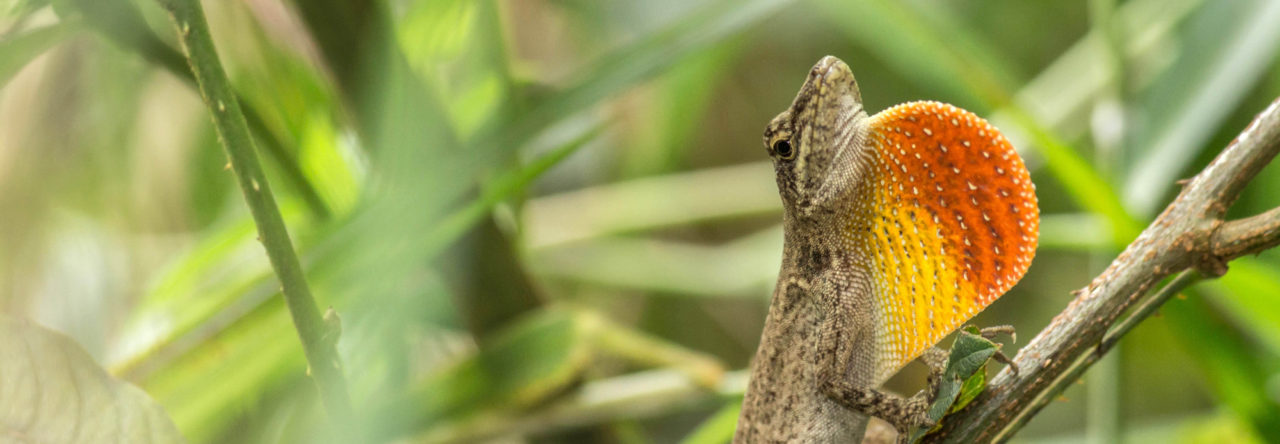Several years ago, I wrote a series of papers and blog posts about the diversity of anole head shape and its developmental origins. My colleagues and I touched on disparate topics such as whether the head differences among species are similar to post cranial ecomorphology, whether the patterns of cranial modularity are conserved across anoles, and the developmental bases of sexual dimorphism in skull shape.
Since starting my own lab at Loyola University in Chicago last year, I am revisiting these projects on skull evolution. Like in much of science, I have found that my early forays into this area created more questions than answers. Understanding the diversity of skull shape among anoles and other iguanid lizards will be one of the first focal areas of my new lab. We are currently mining museum collections to understand how the variation in anole skulls compares to iguanid lizards more broadly. The ultimate goal, however, is to return to questions about the developmental origins of this variation. Just how many different ways has development been modified to generate all the variation we observe in adult anatomy? We do not yet know.
This is where my attention turns to you. To thoroughly flesh out the developmental origins of anatomical diversity, I must have robust sampling of species across the iguanid phylogeny. I am asking the community to please think of me and my students if you have extra breeding animals, eggs, or hatchlings of any species of anole or another iguanid lizard. I am happy to help offset the cost of the animals or collaborate in a mutually beneficial manner.
One of the most exciting species that have recently had the fortune to work with is Anolis hendersoni. For its body size, this species has one of the longest faces of all anoles. In this case I was contacted by the owner of Backwater Reptiles who had several A. hendersoni adults that we are hoping to get eggs from over the next year at Loyola. The folks at Backwater have been great to discuss “exotic” anoles with as they occasionally receive species like A. woodi, A. cybotes, and Chamaeleolis, all of which could be great additions to my project. This is just one example of how I am trying to broaden the sampling for this project. I ask you, the broader anole community, to help me increase my sampling further. I sincerely thank anyone that has leads for me in advance.
- Short Faces, Two Faces, No Faces: Lizards Heads Are Susceptible to Embryonic Thermal Stress - December 15, 2021
- The Super Sticky Super Power of Lizards: a New Outreach Activity for Grade-Schoolers - April 9, 2018
- Updates on the Development of Anolis as a “Model Clade” of Integrative Analyses of Anatomical Evolution - September 4, 2017



Chuck Horne
Hi,
If this year is like last, I anticipate hatching at least a dozen Anolis equestris (had 14 hatch last year and several eggs went bad that I unfortunately did not recover in a timely manner – from just 1 female!) in the spring and summer. I’ll gladly donate a few to your study – getting them to you will be the issue. If you’re able to cover shipping, I can supply a few hatchlings. Just so I know, do you keep them alive or preserve for latter study? Thanks,
Chuck
Thomas Sanger
That would be amazing! I could most certainly cover shipping. Please let me know when the time is right and we will work on the details. As an aside, we have also had great luck shipping eggs, which may save you some effort.
tsanger [AT] luc.edu
Chuck Horne
Hi Thomas, are you still in need of hatchlings? Unfortunately, my group of equestris have not produced any viable eggs this year, but I do have several Anolis smallwoodi hatchlings (and eggs). In the reptile hobby these can be quite expensive, but if you are interested I will gladly give a steep discount. You can check out my YouTube channel: https://www.youtube.com/c/ChuckHorneTheLizardRoom
I have several videos that showcase my anoles, hatchlings, and eggs.
Thomas Sanger
Chuck, thanks for remembering me! Unfortunately, all of the data I have up to his point is on A. equestris, so I don’t know how useful A. smallwoodi will be. That said, would you please shoot me an email with the details? tsanger@luc.edu